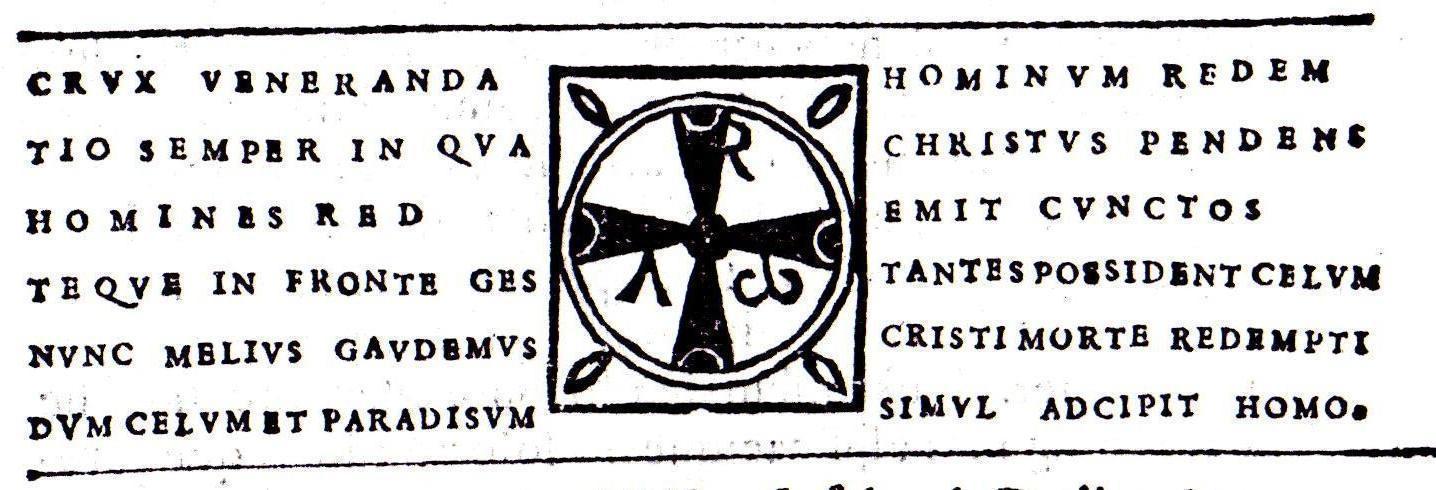CO5 Inscripción cristiana funeraria
Referencia CIL II2/ 7, 637, CLE 2188 | Descripción | Letra | Localización | Cronología | Edición epigráfica | Traducción | Aparato crítico | Comentario | Tipo de verso | Texto dividido en versos y signos métricos | Imágenes | Bibliografía | Enlace a BBDD | Nombre de autor/autores |
CO5 Inscripción cristiana funeraria
Descripción
- Idno filename 22/01/0047
- Tipo de inscripción: Operis Christ.
-
Campo epigráfico:
- Disposición del texto en el soporte: Although there is no information on the medium, there is evidence for the text layout and iconography, thanks to the drawing of DÍAZ DE RIVAS, who copies the inscription just as it is, including the orthography (as it is and with the orthography it contains): there is no line-verse correspondence. In the centre of the space reserved for the text there appears a wide monogrammed cross pattee; an <R> (Latinised version of the rho of Christos) appears to the right of the top of the upright while an alpha and omega “hang” from the crossbar. The cross is framed by two concentric circumferences which in turn lie inside a square (although this may only be in the transcription of DÍAZ DE RIVAS).
Localización
- Lugar de hallazgo: Found in Córdoba, in Plaza del Potro, ad limen ianuae Roderici Alfonsi MAMERANVS.
- Geolocalizacion
- Ubicación con NOMENCLATURA MODERNA con ESCALA MACRO España / Córdoba
- Ubicación con NOMENCLATURA ANTIGUA con ESCALA MACRO Hispania / Baetica / Cordubensis / Corduba
Cronología
- Datación de la inscripción: Entre el año 501 y el año 599
Tipo de verso
- Tipo de verso: Acentual
- Corresp. verso/línea: No
- Distinc. prosa/verso: No
Edición epigráfica
crux veneranda ⊂chrismo⊃ hominum redem(p)-
tio semper in qua ⊂chrismo⊃ Christus pendens
homines red ⊂chrismo⊃ emit cunctos
teque in fronte ges ⊂chrismo⊃ tantes possident c(a)elum
5 nunc melius gaudemus ⊂chrismo⊃ C(h)risti morte redempti
dum c(a)elum et paradisum ⊂chrismo⊃ simul adcipit homo
Texto dividido en versos y signos métricos
Crux veneranda, hominum redemptio semper, ~́~~~́~/~́~~̀~~́~~~́~
in qua Christus pendens homines redemit cunctos ~̀~~́~~́~/~́~~~́~~~́~
teque in fronte gestantes possident caelum. ~́~~́~/~~́~~́~~~́~
Nunc melius gaudemus Christi morte redempti, ~~́~~̀~~́~/~́~~́~~~́~
5 dum caelum et paradisum simul adcipit homo. ~~́~~̀~~́~/~́~~́~~~́~
Traducción
Venerable cross, the eternal salvation of men, on which Christ crucified redeemed all men. Those who wear you on their forehead possess heaven. Now, redeemed by the death of Christ, we rejoice all the more when man receives heaven and paradise at the same time.
Bibliografía
Mameranvs, c.a. 1533–1535, in apographis: Staats- und Stadtbibliothek 4ª Cod. H(alder) 26, 15v. et Niedersächsische Landesbibliothek, ms. XXVIII 1634, I, 4; San Antonio y Castro 1657, 25 (inde Masdeu 1791, vol. 9, 472, n. 12); ex eis Hübner, IHC 125 (inde Wordsworth 1872, 157 [inde Hübner, IHC suppl. 58]; Lommatzsch, CLE 2188, cuius exemplum in linguam Hispanicam vertit Fernández Martínez 1998-99; Vives, ICERV 339; González Fernández 2002, 41); Díaz de Rivas 1624, 24 (inde Stylow, II2/7, 637; Martín Camacho, CLEB ES, CO1, qui in linguam Hispanicam vertit). – Cf. Brakman 1930, 329–338; Vives 1944, 194–195; Sanders 1982, 373 adn. 127; Escolà – Martínez Gázquez 2002, 236; Rodríguez-Pantoja 2008, 299; Rico 2009, 42–44. Díaz de Rivas et Stylow exc., ceteri versus aliter dividerunt. San Antonio y Castro (et inde Masdeu) solum quattuor prima verba transmittit.
Aparato crítico
4 teque in gestantes Mameranvs; ingestantes Wordsworth et Sanders; in gestantes IN SE aut ITA aut simile scriptum fuisse putat Lommatzsch; in [corde] gestantes sospecho, y es casi seguro, que después de in (final de línea) falta una palabra exigida también por el hexámetro, quizá: in [corde] o in [fronte] gestantes Vives, González Fernández. – 5 Christi omnes exc. Díaz de Rivas. – 6 Sina Mameranvs, Hübner; Sina pro Sion? Wordsworth; Sina pro una Brakman; Sina conligatis litteris simul esse proposuit Lommatzsch et Sanders; Sina = Sinai Vives, González Fernández; acipit omnes exc. Díaz de Rivas.
Comentario
Stress-based hexameters of fourteen syllables, except the second, which has fifteen, and the third, which has thirteen. The content of the text revolves around a single theme: the salvation of Christ’s followers through his death on the cross, cf. Sanders 1991, 247-250. A message repeated in all five verses using the repetition of terms: Crux / Christus / te / Cristi… hominum /homines / gestantes / homo… redemtio / redemit / redempti. Ll. 1-2 redemtio for redemptio. L. 4, teque in fronte gestantes, has given rise to problems in exegesis (uid. app. crit.), but the reading of Díaz de Rivas, who saw the text, is supported by the following parallels from St. Augustine, where the sign of the cross of those baptised is explained as the symbol of salvation, Serm. 342,1: est ergo hoc signum quod in fronte gestamus and In Ioh. Euang. 3,2: Huius signum in fronte gestamus); this interpretation suggests to Rico that it is an inscriptio ad fontes (ll. 4 and 6 celum for caelum; use of dum for cum; and the etymological spelling adcipit instead of accipit. In l. 6, for celum et paradisum, the adverb simul could suggest two different concepts, that of heaven being in paradise or the entry to paradise, or perhaps it is a simple variant of the expression coeleste paradisum.
Crux ueneranda hominum redemtio semper,
In qua Christus pendens homines redemit cunctos
Teque in fronte gestantes possident celum.
Nunc melius gaudemus Cristi morte redempti,
5 Dum celum et paradisum simul adcipit homo.
Cuius temporis sit omnino incertum Hübner. Probably before the IX century Vives. Crux plane artem Visigotharum redolet. Est saec. VII fere Stylow. However, there is also a clear parallel for the form of the chrismon, inside a circle and with a Latin cross, in Kokanaya, Syria, year 431 (cf. Cabrol-Leclercq 1948, s.u. chrisme, col. 1507, fig. 2853). According to Cabrol-Leclercq, the monogram cross became more popular than the Constantinian cross in the middle of the 5th c. AD and the use of Latin <R> for Greek <P> also appeared around this date. According to the same author, these features would have appeared later in Hispania, towards the 6th c. AD. However, examples from Hispania of these two features already appear in the middle of the 5th c., cf. Vives 24, Mérida, 442 AD, Latinised chrismon within a crown. There are examples from up to the 7th c. In Baetica, mainly found in the 6th c. For parallels in Hispania of this type of chrismon, cf. IHC 186, Tortosa, end of 6th c. (although the symbol could be later); Vives 148, Morón de la Frontera, Sevilla, 466 or 504; Gómez Pallarès PEPC, T2, Tarragona, 4th-5th c.; Vives 248, Barcelona, 5th-6th c. There is therefore nothing to prevent it from appearing one century earlier.
Nombre de autor/autores
- Nombre de autor/autores:J. Martín Camacho
- Última modificación2024-03-14 17:58:21
Puedes descargar esta





